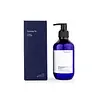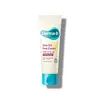What's inside
What's inside
 Key Ingredients
Key Ingredients

 Benefits
Benefits

 Concerns
Concerns

 Ingredients Side-by-side
Ingredients Side-by-side

Water
Skin ConditioningGlycerin
HumectantDipropylene Glycol
HumectantCaprylic/Capric Triglyceride
MaskingIsopropyl Palmitate
EmollientPolyglyceryl-3 Distearate
EmulsifyingButyrospermum Parkii Butter
Skin ConditioningPentaerythrityl Stearate/Caprate/Caprylate/Adipate
EmollientHydroxyethyl Urea
HumectantCentella Asiatica Extract
CleansingCamellia Sinensis Leaf Extract
AntimicrobialMentha Viridis Extract
MaskingLonicera Japonica Flower Extract
Skin ConditioningCalendula Officinalis Flower Extract
MaskingMelilotus Officinalis Extract
AstringentTrehalose
HumectantHelianthus Annuus Seed Oil
EmollientMacadamia Ternifolia Seed Oil
EmollientOlea Europaea Fruit Oil
MaskingSodium Hyaluronate
HumectantSodium Acetylated Hyaluronate
HumectantHydrolyzed Hyaluronic Acid
HumectantHydroxypropyltrimonium Hyaluronate
Sodium Hyaluronate Crosspolymer
HumectantCeramide Ns
Skin ConditioningCeramide NP
Skin ConditioningCeramide EOP
Skin ConditioningPotassium Cetyl Phosphate
EmulsifyingBrassica Campestris Sterols
EmollientCholesterol
EmollientPhytosteryl/Behenyl/Octyldodecyl Lauroyl Glutamate
Skin ConditioningPolyglyceryl-10 Oleate
Skin ConditioningStearic Acid
CleansingPalmitic Acid
EmollientOleic Acid
EmollientMyristic Acid
CleansingArachidic Acid
CleansingSorbitan Stearate
EmulsifyingStearyl Alcohol
EmollientGlyceryl Stearate Citrate
EmollientSodium Polyacryloyldimethyl Taurate
Emulsion StabilisingCarbomer
Emulsion StabilisingTromethamine
BufferingHydrogenated Polydecene
EmollientHydrogenated Lecithin
EmulsifyingEthylhexylglycerin
Skin ConditioningXanthan Gum
EmulsifyingDisodium EDTA
Trideceth-10
CleansingTocopherol
AntioxidantButylene Glycol
HumectantCaprylyl Glycol
EmollientPentylene Glycol
Skin ConditioningHydroxyacetophenone
Antioxidant1,2-Hexanediol
Skin ConditioningWater, Glycerin, Dipropylene Glycol, Caprylic/Capric Triglyceride, Isopropyl Palmitate, Polyglyceryl-3 Distearate, Butyrospermum Parkii Butter, Pentaerythrityl Stearate/Caprate/Caprylate/Adipate, Hydroxyethyl Urea, Centella Asiatica Extract, Camellia Sinensis Leaf Extract, Mentha Viridis Extract, Lonicera Japonica Flower Extract, Calendula Officinalis Flower Extract, Melilotus Officinalis Extract, Trehalose, Helianthus Annuus Seed Oil, Macadamia Ternifolia Seed Oil, Olea Europaea Fruit Oil, Sodium Hyaluronate, Sodium Acetylated Hyaluronate, Hydrolyzed Hyaluronic Acid, Hydroxypropyltrimonium Hyaluronate, Sodium Hyaluronate Crosspolymer, Ceramide Ns, Ceramide NP, Ceramide EOP, Potassium Cetyl Phosphate, Brassica Campestris Sterols, Cholesterol, Phytosteryl/Behenyl/Octyldodecyl Lauroyl Glutamate, Polyglyceryl-10 Oleate, Stearic Acid, Palmitic Acid, Oleic Acid, Myristic Acid, Arachidic Acid, Sorbitan Stearate, Stearyl Alcohol, Glyceryl Stearate Citrate, Sodium Polyacryloyldimethyl Taurate, Carbomer, Tromethamine, Hydrogenated Polydecene, Hydrogenated Lecithin, Ethylhexylglycerin, Xanthan Gum, Disodium EDTA, Trideceth-10, Tocopherol, Butylene Glycol, Caprylyl Glycol, Pentylene Glycol, Hydroxyacetophenone, 1,2-Hexanediol
Water
Skin ConditioningUrea
BufferingTheobroma Cacao Seed Butter
EmollientGlycerin
HumectantPropanediol
SolventCetearyl Alcohol
EmollientCocoglycerides
EmollientButyrospermum Parkii Butter
Skin ConditioningSorbitan Stearate
EmulsifyingPolyglyceryl-10 Distearate
EmulsifyingPanthenol
Skin ConditioningGlyceryl Stearate
EmollientSqualane
EmollientStearic Acid
CleansingCamellia Oleifera Seed Oil
Skin ConditioningCaprylyl Methicone
Skin ConditioningDimethicone
Emollient1,2-Hexanediol
Skin ConditioningCaprylyl Glycol
EmollientEuphorbia Cerifera Wax
Xanthan Gum
EmulsifyingTocopheryl Acetate
AntioxidantArginine
MaskingDisodium EDTA
Vitis Vinifera Seed Oil
EmollientCamellia Japonica Seed Oil
EmollientChamaecyparis Obtusa Oil
MaskingCitrus Aurantium Bergamia Fruit Oil
MaskingCitrus Medica Peel Oil
Origanum Majorana Leaf Oil
MaskingCaprylic/Capric Triglyceride
MaskingMyristoyl/Palmitoyl Oxostearamide/Arachamide Mea
Skin ConditioningPhytosterols
Skin ConditioningParfum
MaskingWater, Urea, Theobroma Cacao Seed Butter, Glycerin, Propanediol, Cetearyl Alcohol, Cocoglycerides, Butyrospermum Parkii Butter, Sorbitan Stearate, Polyglyceryl-10 Distearate, Panthenol, Glyceryl Stearate, Squalane, Stearic Acid, Camellia Oleifera Seed Oil, Caprylyl Methicone, Dimethicone, 1,2-Hexanediol, Caprylyl Glycol, Euphorbia Cerifera Wax, Xanthan Gum, Tocopheryl Acetate, Arginine, Disodium EDTA, Vitis Vinifera Seed Oil, Camellia Japonica Seed Oil, Chamaecyparis Obtusa Oil, Citrus Aurantium Bergamia Fruit Oil, Citrus Medica Peel Oil, Origanum Majorana Leaf Oil, Caprylic/Capric Triglyceride, Myristoyl/Palmitoyl Oxostearamide/Arachamide Mea, Phytosterols, Parfum
Ingredients Explained
These ingredients are found in both products.
Ingredients higher up in an ingredient list are typically present in a larger amount.
1,2-Hexanediol is a synthetic liquid and another multi-functional powerhouse.
It is a:
- Humectant, drawing moisture into the skin
- Emollient, helping to soften skin
- Solvent, dispersing and stabilizing formulas
- Preservative booster, enhancing the antimicrobial activity of other preservatives
This ingredient is also known as shea butter. It is an effective skin hydrator and emollient.
Emollients help soothe and soften your skin. It does this by creating a protective film on your skin. This barrier helps trap moisture and keeps your skin hydrated. Emollients may be effective at treating dry or itchy skin.
Shea butter is rich in antioxidants. Antioxidants help fight free-radicals, or molecules that may harm the body. It is also full of fatty acids including stearic acid and linoleic acid. These acids help replenish the skin and keep skin moisturized.
While Shea Butter has an SPF rating of about 3-4, it is not a sunscreen replacement.
Shea butter may not be fungal acne safe. We recommend speaking with a professional if you have any concerns.
Learn more about Butyrospermum Parkii ButterThis ingredient is an emollient, solvent, and texture enhancer. It is considered a skin-softener by helping the skin prevent moisture loss.
It helps thicken a product's formula and makes it easier to spread by dissolving clumping compounds.
Caprylic Triglyceride is made by combining glycerin with coconut oil, forming a clear liquid.
While there is an assumption Caprylic Triglyceride can clog pores due to it being derived from coconut oil, there is no research supporting this.
Learn more about Caprylic/Capric TriglycerideCaprylyl Glycol is a humectant and emollient, meaning it attracts and preserves moisture.
It is a common ingredient in many products, especially those designed to hydrate skin. The primary benefits are retaining moisture, skin softening, and promoting a healthy skin barrier.
Though Caprylyl Glycol is an alcohol derived from fatty acids, it is not the kind that can dry out skin.
This ingredient is also used as a preservative to extend the life of products. It has slight antimicrobial properties.
Learn more about Caprylyl GlycolDisodium EDTA plays a role in making products more stable by aiding other preservatives.
It is a chelating agent, meaning it neutralizes metal ions that may be found in a product.
Disodium EDTA is a salt of edetic acid and is found to be safe in cosmetic ingredients.
Learn more about Disodium EDTAGlycerin is already naturally found in your skin. It helps moisturize and protect your skin.
A study from 2016 found glycerin to be more effective as a humectant than AHAs and hyaluronic acid.
As a humectant, it helps the skin stay hydrated by pulling moisture to your skin. The low molecular weight of glycerin allows it to pull moisture into the deeper layers of your skin.
Hydrated skin improves your skin barrier; Your skin barrier helps protect against irritants and bacteria.
Glycerin has also been found to have antimicrobial and antiviral properties. Due to these properties, glycerin is often used in wound and burn treatments.
In cosmetics, glycerin is usually derived from plants such as soybean or palm. However, it can also be sourced from animals, such as tallow or animal fat.
This ingredient is organic, colorless, odorless, and non-toxic.
Glycerin is the name for this ingredient in American English. British English uses Glycerol/Glycerine.
Learn more about GlycerinSorbitan Stearate comes from sorbitol and stearic acid. Sorbitol is a type of sugar and stearic acid is a fatty acid.
It is used as an emulsifier and helps ingredients stay together by creating water-in-oil emulsions.
This ingredient may not be Malassezia folliculitis, or fungal-acne safe.
Stearic Acid is a fatty acid. It is an emollient, emulsifier, and texture enhancer.
As an emollient, stearic acid helps soften skin. It aids the skin's protective barrier by preventing water loss. It also provides a gentle cleansing effect without stripping away natural oils.
Stearic acid may also be used to enhance the texture of products. It can add volume and stabilize ingredients such as water and oil. This can help water and oil ingredients from separating.
Sources of stearic acid include animal or vegetable fats/oils such as coconut or shea. It can be naturally found in butter, cocoa butter, shea butter, vegetable fats, and animal tallow.
This ingredient may not be Malassezia folliculitis, or fungal-acne safe.
Learn more about Stearic AcidWater. It's the most common cosmetic ingredient of all. You'll usually see it at the top of ingredient lists, meaning that it makes up the largest part of the product.
So why is it so popular? Water most often acts as a solvent - this means that it helps dissolve other ingredients into the formulation.
You'll also recognize water as that liquid we all need to stay alive. If you see this, drink a glass of water. Stay hydrated!
Learn more about WaterXanthan gum is used as a stabilizer and thickener within cosmetic products. It helps give products a sticky, thick feeling - preventing them from being too runny.
On the technical side of things, xanthan gum is a polysaccharide - a combination consisting of multiple sugar molecules bonded together.
Xanthan gum is a pretty common and great ingredient. It is a natural, non-toxic, non-irritating ingredient that is also commonly used in food products.
Learn more about Xanthan Gum